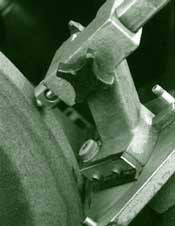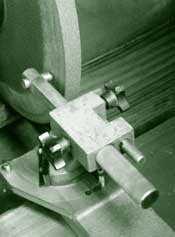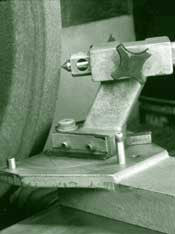By Jim Tapp (retired)
Manual dressing of the grinding wheel is an important factor in producing satisfactory work on your crankshaft grinder. The wheel must be dressed each time it is placed on the machine, even though it may not have been removed from the wheel center.
Mount the wheel dresser on the grinder table. Bring the rotating grinding wheel up close to the diamond and start the coolant flow. Never dress without coolant. Frictional heat buildup can cause the diamond to come loose or separate from its mount. Lack of lubricating properties, along with cooling, needlessly abrades the diamond.
 Face Dressing
Face Dressing
Best results will be obtained if the diamond is brought into contact with the center of the wheel, fed in a maximum of .002″, then traversed each direction (left and right) off the edge of the wheel. Learning the best traverse rate for dressing the wheel is a matter of trial and error for each operator. You have to be fast enough to prevent glazing, but slow enough to minimize spiral lead marks. Dressing from the center of the wheel out to each edge helps minimize the effect of the spiral lead marks on the finish of the workpiece. Do not remove over .002″ per pass. Excessive in-feed will cause the wheel to act like it’s loaded. This results from wheel material being “pasted” into new exposed wheel porosity.
The type of dress applied to the grinding wheel may be changed to suit different grinding needs. A rapid traverse will remove large amounts of material quickly. A slower traverse will produce a more desirable finish, but won’t remove material as rapidly.
 Side Dressing
Side Dressing
Whenever the sides of a grinding wheel are found to run out, they should be dressed. With the dresser mounted to a table, bring the diamond into contact with the grinding wheel near its front corner, feed in a maximum of .002″. The wheel is then fed in and out until the necessary amount has been dressed from each side of the wheel.
 Radius Dressing
Radius Dressing
When regrinding a crankshaft, every effort should be made to duplicate the original corner radii to prevent the crankshaft from being weakened. Position the diamond in the holder facing out the front. Slide the holder back, position and lock the radius adjuster at the desired dimension. Then slide the diamond holder forward until the diamond contacts the radius adjustment stop. Tighten the diamond holder, unlock and retract the adjustment stop. Feed the wheel into position fully forward. Using fine feed, bring the diamond into contact with the front face of the wheel and dress the full width. Then back the wheel away from the diamond .004″, loosen the swivel lock and remove one of the stop pins so the upper swivel can be rotated 90° of travel. While pivoting the diamond through its 90° arc, bring the wheel into contact and dress of the required amount from one corner. Repeat this process for the opposite corner by replacing the first stop pin and removing the second pin to provide 90° rotation in the opposite direction.
Be sure to keep your diamond dresser tools sharp. Rotate the diamond 30 to 45° after each dressing operation.
Remember, if you have more questions, contact the Goodson Tech Department at 1-800-533-8010.
